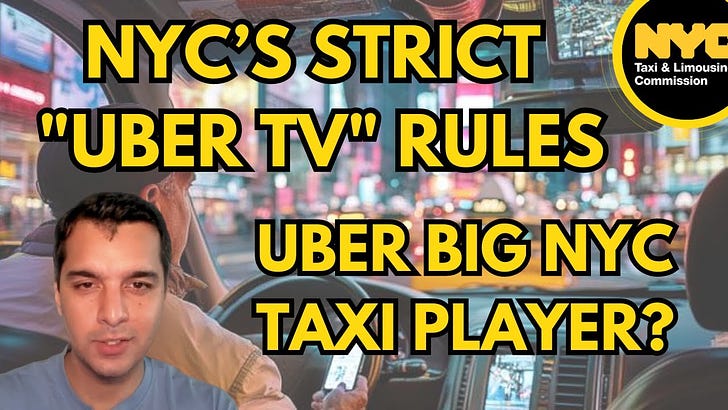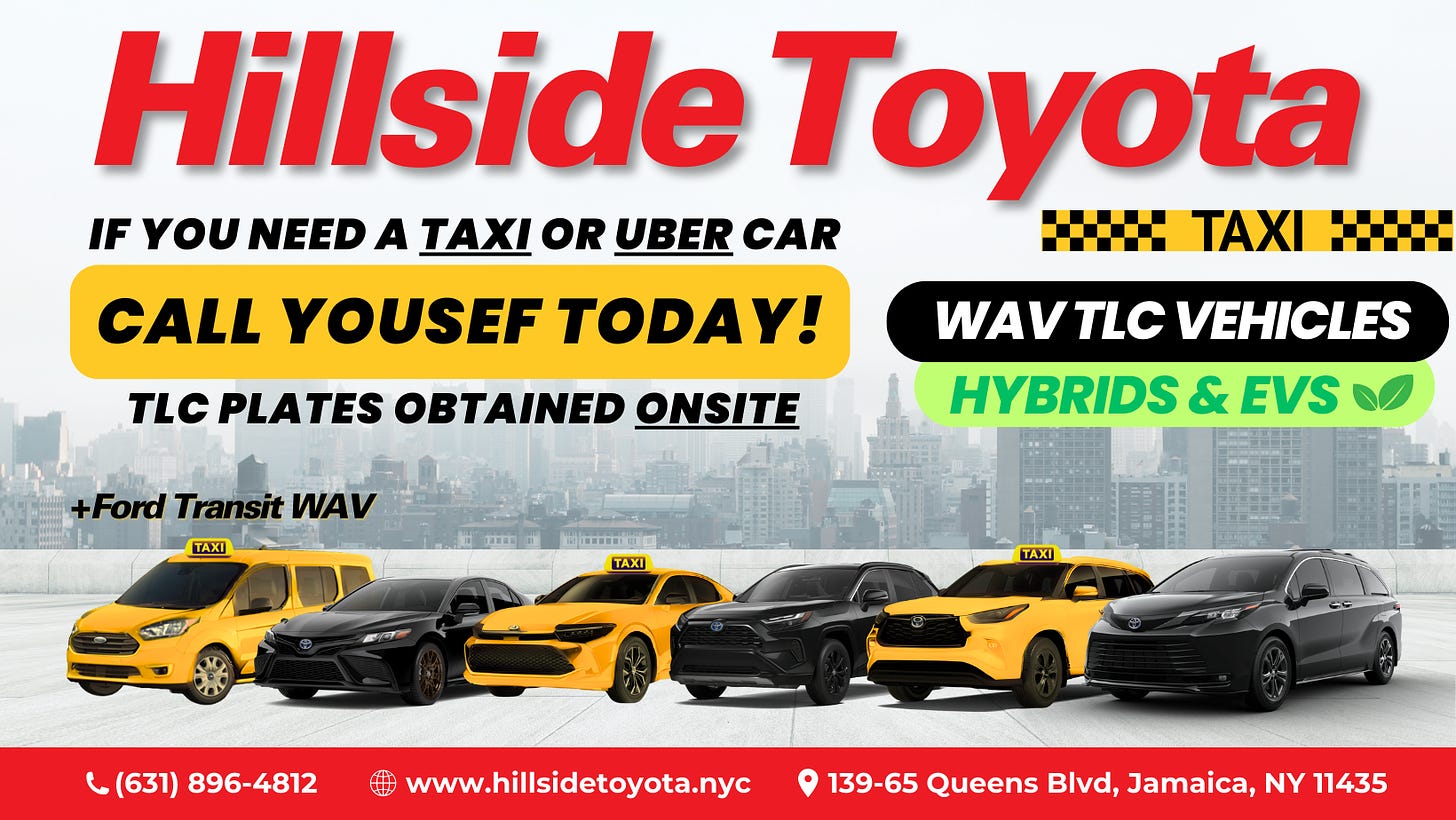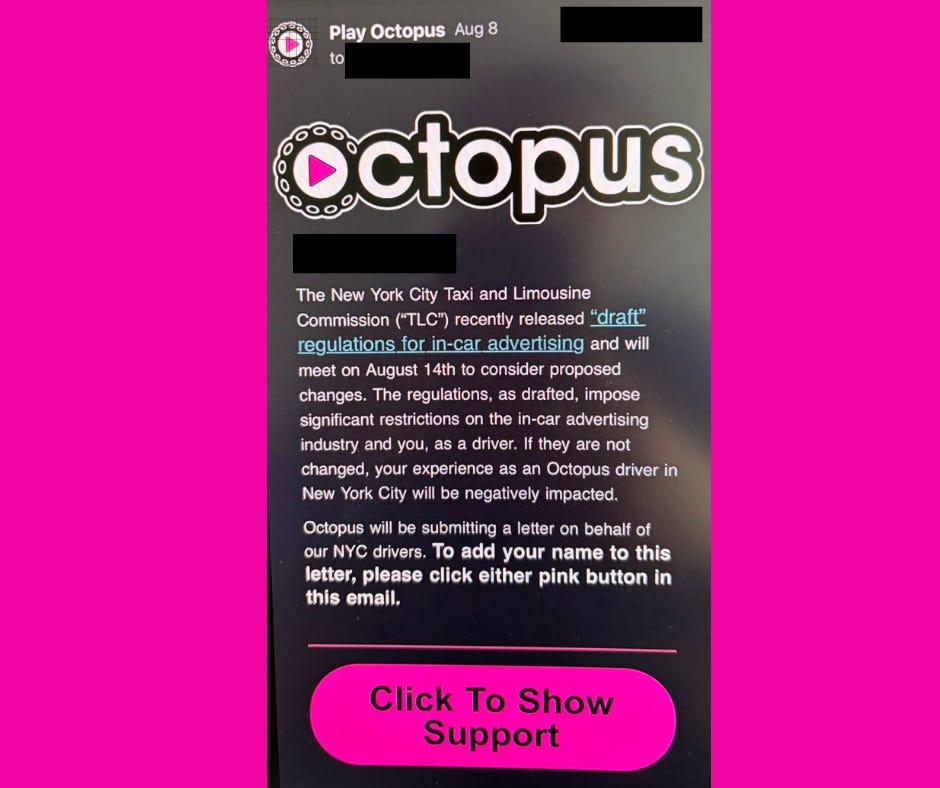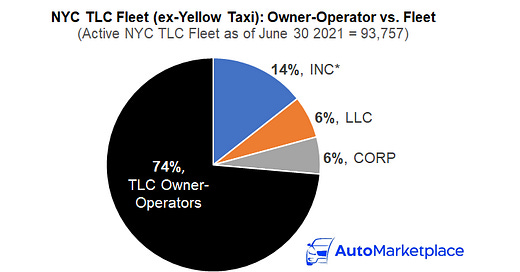

Discover more from AutoMarketplace
📺🚕 NYC TLC Proposes Strict "Uber TV" Rules, Uber Set To Become Big Player In Yellow Cab Industry
TLC is holding in-person hearing this Wednesday to discuss proposed rules related to interior advertising in non-taxi NYC for-hire vehicles (FHVs). TLC will also vote on taxi "Flex Fare" regulations
NYC Council passed bill in December 2023 to allow for in-vehicle advertising tablets, despite TLC protests and passenger experience with NYC “Taxi TV”
The TLC is holding a public hearing this Wednesday, August 14th at 10am to discuss launching new in-vehicle ad tablet rules and licensing regime
NYC TLC drivers must earn at least 25% of gross ad revenue generated from ad tablet, cannot be forced to use tablet and must be paid on a weekly basis
Leasing companies, Uber and/or Lyft will not be allowed to make any recurring revenue from ad tablets and only one ad tablet is allowed in a vehicle
T-Mobile’s Octopus Interactive believes proposed rules are unnecessarily prohibitive and has asked NYC TLC drivers to sign a letter it has drafted
TLC will also vote on taxi “Flex Fare” regulations during Commission meeting, officially allowing yellow cabs to offer upfront pricing (vs. taximeter)
The NYC Taxi & Limousine Commission (TLC) is holding an in-person meeting this Wednesday, August 14th at 10am. The meeting will take place in a hearing room at 33 Beaver Street, 19th Floor, New York, NY 10004.
The meeting can also be attended virtually by visiting TLC’s website this Wednesday at ~10am and following the website prompt to watch the live webcast.
🗣️ Do you want to speak at the TLC hearing on Wednesday, August 14th at 10am?
To sign up to speak and provide testimony, you must e-mail the TLC at tlcrules@tlc.nyc.gov or call 212-676-1135 by 5:00 p.m. on Tuesday, August 13, 2024. Speakers will not be able to sign up to testify the day of the hearing.
Those who did not sign-up in advance to testify are welcome to view the live-stream of the meeting on TLC’s website. Please note that the hearing is for accepting oral testimony only and is not held in a “Question and Answer” format.
You can also submit comments to the TLC on its website, by email, by mail and/or by fax. Please open the PDFs below for more information, including instructions on how to participate in the hearing if you need assistance (e.g., have a disability).
📋 Meeting Agenda
There are four main parts to the meeting.
Approving new base applications
Report on Enforcement by the Deputy Commissioner for Uniformed Services Bureau (USB) - Ira Goldapper will present
Commission vote on proposed Flex Fare rules
Public hearing on proposed rules related to interior advertising
Video Summary of Article
Below AutoMarketplace’s Dawood Mian provides a video summary of what will be discussed in this article.
*Table of Contents*
0:00 Intro 1:09 Summary of upcoming NYC TLC public hearing 3:40 How to speak at NYC TLC hearing? 5:12 Meeting agenda 6:20 Proposed in-vehicle (FHV) advertising rules 10:05 Simple summary of proposed rules for in-vehicle ads 15:01 Leasing companies can't make money on ad tablets? 17:18 T-Mobile's Octopus not happy about proposed rules 23:40 Our thoughts on proposed in-FHV ad rules 26:22 NYC "Taxi TV" background (WSJ) 26:48 Background to Flex Fare regulations and Commission vote? 28:48 Taximeter vs. Flex Fare 34:48 Bill Ackman says Uber stealing NYC taxi driver tips? 37:58 Flex Fare officially starts new era in yellow cab industry 38:13 Uber dispatches to NYC yellow cabs = Curb / Arro dispatches 39:02 Uber dispatches to taxis, not subject to UR or driver pay rules ("lockouts") 40:02 Our thoughts on Flex Fare regulations
Article continues after advertisement
Proposed In-Vehicle Advertising Rules
The City Council passed a bill, late last year and with some additional amendments earlier this year, that would allow NYC TLC-licensed drivers and fleets to be able to display electronic advertising tablets in their for-hire vehicles (FHVs).
The bill was sponsored by NYC Council Member Amanda Farías and supported by the City Council’s Committee on Transportation and Infrastructure. It passed a full City Council vote 47-0 in December 2023 and now has officially become law, despite TLC criticism and testimony against allowing in-vehicle ads.
“Some of you maybe asking, why did I introduce this bill? Why does the City Council decide if our drivers get to have in-car advertising or not? The New York City Taxi & Limousine Commission regulates interior and exterior vehicle advertising…over the last five years, drivers have been subject to the slow, bureaucratic process…what makes today so important, is that drivers will no longer be subject to TLC policy changes and their opportunity for advertising will be cemented into law, for years to come.”
- NYC Council Member Amanda Farías
TLC’s 30+ Page PDF
The TLC published its initial proposed rules related to in-vehicle advertising in a 37 page PDF (see below), which is a fairly dense document that is not easy to read. We understand the rulemaking process is complex and requires certain procedures and protocols to be followed, but a simple summary of proposals that the “average” NYC driver could understand would have been nice. TLC’s bullet point summary goes over the goals of rules, rather the the specific proposals.
Below we’ve done our best to flag what we believe are the significant (not all) TLC rule proposals related to in-vehicle advertising. Please let us know if you think we missed any.
💰 25% Gross Ad Revenue Goes To Driver & Weekly Payments: The TLC-licensed Interior Advertising Provider must at minimum pay a driver using their tablet 25% of gross revenue and on no less than a weekly basis. (pdf pg. 21-26, 29)
🥊 No Retaliation Against Drivers: The TLC basically says a driver can’t be punished if they choose to work, or not to work, with a tablet provider (e.g. choosing Lyft vs. Uber sponsored tablet). (pdf pg. 3, 5, 6, 26)
1️⃣ Only One Ad Tablet In A Vehicle: A for-hire vehicle (FHV) may be equipped with one “Approved Electronic Tablet” mounted in a fixed position. (pg. 4. 35)
💸 Leasing Company, Base, Uber, Lyft Can’t Make Money On Ads: A leasing company, base, Uber and/or Lyft cannot share in any revenue generated from an interior ad tablet. (pdf pg. 4-6)
✅ Only TLC-licensed Ad Tablets Can Be Used & Authorized Ads Can Be Displayed: Only an ad tablet licensed by the TLC can be used and only TLC-approved ads can be displayed. (pdf pg. 4, 6-8, 10-37)
✅ 15% of content must be TLC-provided: 15% of ad tablet content will be TLC-provided content. (pg. 33)
❌ Passenger Can’t Make Payment or Browse Internet Via Ad Tablet & Tablet Must Have Easy Controls: Passenger payment cannot be processed through interior ad tablet, tablet should have no internet browsing capability and passengers should have ability to easily mute, control or turn off the ad tablet. (pdf pg. 8, 32, 33)
🐙 T-Mobile’s Octopus Not Happy
If you know the recent history of in-vehicle ad tablets becoming legal in NYC, you’ll know T-Mobile-owned Octopus Interactive, a well known tablet provider among NYC drivers, and the TLC were in a head-to-head battle last year. The TLC actually sent a industrywide email distribution in October 2023, specifically naming the company as illegally operating in the City, which, to be fair, it technically was at the time.
Well, as you could have probably guessed from our bullet point summary above and the 30+ page PDF laying out TLC’s proposed rules on interior advertising, although in-FHV advertising tablets are now legal, the war is not over.
Octopus sent the below email, with hyperlink to a letter addressed to the TLC, asking drivers to support the T-Mobile-owned company’s push to ask that the proposed rules be amended (i.e., less restrictive).
Below we paste the text from Octopus’ email, if the “Click to Show Support” hyperlink is engaged.
Octopus will be submitting a letter to the TLC on behalf of our NYC drivers. To add your name to this letter, please respond “SIGN” to the text message you received.
LETTER:
I am a For-Hire-Vehicle driver serving the five boroughs and am writing to share my concerns about the new draft rules for interior advertising proposed by the TLC. When the City Council passed the legislation allowing us to make extra income through interior ads, I was thrilled. However, the current rules do not let us make the most of this opportunity.
The extensive rules around licensing, approved tablets and reporting will restrict competition in the interior advertising industry and limit the extra income I can make as a FHV driver. It’s crucial to cut down on the red tape around implementing advertising programs for us. We need more freedom to choose and manage the tools we use for ads and to have better control over our vehicle systems. Less regulation means the existing companies in the industry can continue operating for the benefit of For-Hire-Vehicle drivers and keep things running smoothly.
The TLC has proposed rule changes that will make it significantly more difficult to operate the tablet. Requiring drivers to manage log on/log off functions, requiring tablets to have physical printing functionality and requiring tablets to implement voice activated features are some of the examples of complicated requirements. As a For-Hire-Vehicle driver, I appreciate the simplicity of existing interior advertising programs and the proposed rules make tablet usage overly complex.
Finally, the rules misunderstand how advertising revenue translates to driver compensation. The TLC rules only consider a traditional “revenue share” whereas existing companies provide a more consistent payment structure that results in well more than 25% of gross ad revenue. The TLC rules use trip data as the basis in several items, as well as the term “shift”. To base our earnings off trip data or “shift length” requires the sharing of information between a High Volume For Hire Service company (or several) and the interior advertising provider. Additionally, only a High Volume For Hire Service company could comply with content or consent requirements that must be shown at the start of a trip.
In summary, I encourage the NYC TLC to amend the draft rules to allow this important industry to operate more freely. Let’s ensure that drivers can fully benefit from the technology designed to assist us.
Octopus will be submitting a letter to the TLC on behalf of our NYC drivers. To add your name to this letter, please respond “SIGN” to the text message you received.
- Octopus Interactive email received by NYC TLC driver on August 8th
Flex Fare TLC Board Vote
As mentioned previously, although the the public hearing about proposed in-vehicle advertising rules will be the “main event”, the TLC Board of Commissioners will also vote ✋on proposed “Flex Fare” yellow taxi and green cab regulations. The Flex Fare Pilot program essentially allowed NYC taxis to offer upfront pricing on “e-hail” or “app-hailed” trips.
There was a ~1.5 hour TLC public hearing on May 8th mostly focused on, at the time, proposed Flex Fare rules and it was fairly contentious. The New York Taxi Workers Alliance (NYTWA), a prominent driver advocacy group, essentially argued that e-hail dispatches should not pay a driver less than the same trip done via a traditional taximeter.
At the time we wrote the following.
The market for NYC street hails is decreasing as a % of total trips. This is not Uber’s fault. Customers prefer using their smartphone to hail FHVs and prefer an upfront price. This does not mean street hails will go to 0, but it might plateau at 5% to 10% of NYC for-hire trips (our guess).
When driver advocates frame the pay from an e-hail trip as less than what it would have been using a taximeter, it’s not really intellectually honest. The trip is fundamentally originating from a third party app, the trip would otherwise not have been a street hail (90%+ of the time let’s say this is true).
Yellow cabs are not forced to accept third party e-hails and the industry still has the exclusive ability to service street hails and create their own app and partner with other companies (not subject to UR!!!) and compete with Uber, Lyft, etc.
…
Honestly, and this is a bit of tough love 🥊❤️ for the taxi medallion industry, if Uber is originating a trip then that is Uber’s customer and they need to be compensated in a way that makes sense. Now, if the yellow cab industry forces Uber to pay them $ X amount and Uber doesn’t want to, guess what? They will send their customers to other NYC FHVs 🤷♀️. If the goal of the yellow cab industry is to force Uber to send them trips, we can’t support that. We do support strictly enforced for-hire vehicle supply caps (with driver-centric protections as we've discussed).
- AutoMarketplace (May 9, 2024)
In response to the public hearing on May 8th the TLC did state the following:
“Furthermore, based on written and oral comments, TLC is amending the proposal to ensure that the Driver will be able to see any fees that the E-Hail Application Provider may charge prior to accepting a trip; as well as, a breakdown of the itemized charges in electronic form after the trip is complete.”
- NYC TLC, Notice of Promulgation for Commission meeting on August 14, 2024
With upfront trip pricing for yellow cabs (& green taxis) becoming official, it marks the beginning of a new era in the taxi medallion industry. Uber executive Josh Gold recently revealed, to City & State, close to 10% of yellow cab trips originated via the Uber app (Note: technically Curb and Arro are dispatching the trips to the driver, but the trips are originating from the Uber consumer app).
As we’ve mentioned, yellow cab “e-hails” are not subject to utilization rules (this is a loophole that uniquely benefits Uber in our opinion, and negatively impacts non-taxi medallion NYC for-hire (TLC) drivers. With “lockouts” still impacting many NYC TLC-licensed drivers who work for Uber, we expect this regulatory dynamic to come under more focus.
“Gold achieved the détente by positioning Uber as an ally in the taxi industry’s recovery; 10% of taxi rides are now referred to Uber drivers.”
- City & State. July 29, 2024
Correction (08.12.2024 - 09:45am): Ira Goldapper is the Deputy Commissioner, Uniformed Services Bureau (USB) and will be presenting. Raymond Scanlon was incorrectly mentioned.
















An ehail is a street hail
Theres a lot of yellow talk in this blog that's why I'm getting in
At our last duel , you gave your definition of a streethail as holding up your hand and being in sight of a cab
This is non other than a self appeasing definition To suit your financial needs
There is nothing in the law that says anything like that
Let’s make it make sense, them knowing how Uber operates or any other ride hailing app, you think any App will go for the option that’s costing them more? Let it be that way and things will fall into place and Uber will stop dispatching to Yellows when there’s FHVs around, at that point they’ll rather deal with UR whether it’s by locking out more drivers or simply becasue that has been put aside with the time, Yellows gotta be careful what they advocate for…the loophole is very clear when it comes to this topic but just easier not to confront it.
Next Hearing/Meeting is going to be pretty interesting honestly, we will probably see many different advocates from different sectors, a lot to talk about. Interior advertising came in with a stronger rule package than the UR itself 😂.